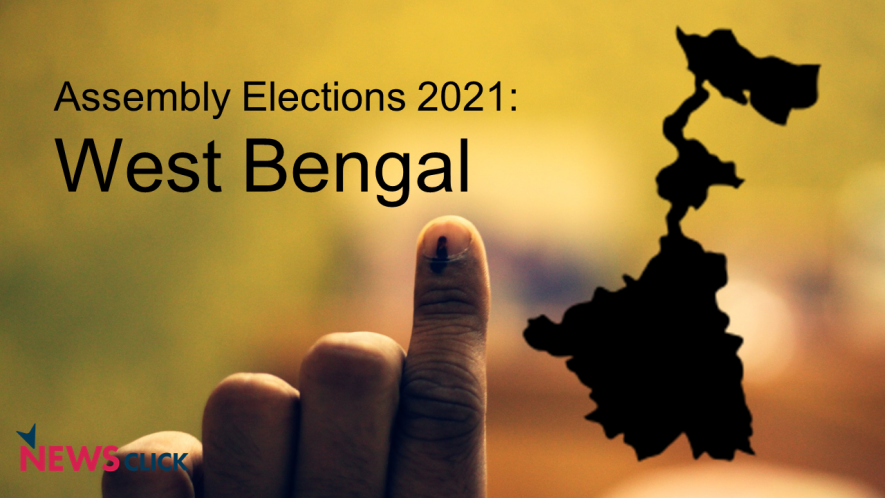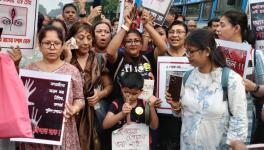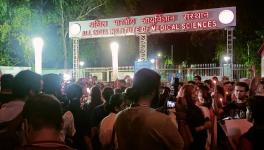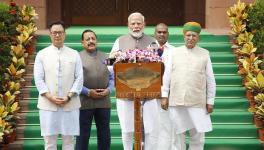Bengal Elections: In Birbhum, TMC’s Political Violence Reason Behind Anti-incumbency

Had the bullet struck three inches towards his right, Shyam Sundar Gorain, 38, would have probably not been able to recount the deadly afternoon from April 2018. Instead, it ruptured his left hand, and sent him to the hospital for a few days. A round, dark spot conspicuously sits right under his elbow even today. “I was among the many that got attacked that day,” said Gorain, adjusting his left sleeve and added, “I was lucky to have come out alive.”
It isn’t every day you get struck by a bullet. The one that hit Gorain was the consequence of political violence in West Bengal, where Assembly elections are currently underway. A resident of Karidhya village in Birbhum district, Gorain is a worker in the Bharatiya Janata Party (BJP). However, unlike in most parts of the country, it can be a daunting task in West Bengal, where the Trinamool Congress (TMC) out-muscles the rest of the parties. “We were merely trying to file the nomination of our candidate for the panchayat elections,” he said, adding, “But TMC’s goons intimidated and attacked us. They made sure we could not file the nomination, and their candidate won unopposed.”
The panchayat elections, or the local body polls, elect people at all tiers of the local government every five years. West Benga is one of the few states in the country which has directly elected representatives at all three levels.
The political parties in West Bengal treat panchayat elections very seriously, for it reflects the organisational strength of the party on the ground. For a state that has a history of political violence, parties understand the importance of a strong cadre at the booth level, which is often tested or strengthened during the panchayat polls.
Also read: Bengal Elections: How TMC Violence Against Left Opened Doors for BJP
However, the desperation to dominate panchayat elections in West Bengal has regularly led to ugly altercations between the political workers of different parties under previous state governments. It did not recede by any standards under the Mamata Banerjee-led TMC government either.
The 2018 panchayat elections, though, were unprecedented. Of the 48,650 posts in Gram Panchayats, 825 posts in Zilla Parishads and 9,217 posts in Panchayat Samitis, nearly 34% of the seats had only one candidate contesting the elections: one who represented the TMC.
However, winning mass walkovers amid allegations of widespread rigging, and use of brute force cost TMC a year later. The anger at TMC’s local level thuggery was one of the reasons behind several voters deserting the party in the 2019 general elections, and moving towards the BJP. In Birbhum, BJP led in four of the seven Assembly segments against all odds.
Two years later, with the Assembly elections underway, the voters have not forgotten the chaos of 2018, especially in the district of Birbhum, which was the worst affected.
Bamdev Gorain, 55, who runs a Kirana shop in Karidhya, said he voted for the BJP in 2019 only to teach TMC a lesson. “Chup Chaap, Kamal Chhap [Keep Silent and Vote for Lotus (BJP’s poll symbol)],” he said, referring to how he silently voted for the BJP while giving an impression that his loyalties remained with the TMC. “Until then, I was a TMC voter. I don’t think I will vote for them again. They deserve to be voted out,” he added.
Bamdev said that the TMC workers have often threatened voters into submission, and intimidated them to vote for the party. “Most people let it pass because there was no one that could stand up to the TMC goons,” he said and added, “The TMC workers enjoy impunity. How do so many seats go uncontested and hardly anyone pays the price for it?”
The Supreme Court in July 2018 had also expressed shock at the number of seats TMC won without a single vote being cast. The record, until then, had been held by the Left Front government in 2003, when 11% of the seats had gone uncontested. “What is puzzling us is that of 48,000 gram panchayat seats, more than 16,000 go uncontested,” a bench headed by then Chief Justice of India Dipak Misra had said.
Shyam Sunder Gorain has the answer to the puzzle. “Normally, a bunch of party workers accompany the candidate on the way to filing nomination. But in 2018, we were attacked with bombs and bullets to keep us away from the nomination,” he said.
One of those bullets had hit Gorain. Around the same time, Kalo Sona Mondal, another BJP worker in the Karidhya panchayat, was stabbed with a knife. “They wanted to stab me in the stomach, but they ended up hurting my back. I know the people. They are TMC workers. But they hardly faced any consequences for the thuggery. The police and administration were in cahoots with the TMC goons,” he said.
The BJP had claimed that 52 of their workers were killed in the run up to the panchayat polls. Even though TMC had denied the charges and claimed that 14 of their workers had died too, the allegations of police and administration abetting TMC’s capture of the panchayat polls had come from several parts of West Bengal.
About 30 km from Karidhya, in the town of Rampurhat in Birbhum, eyewitnesses said the TMC’s strong arming of the panchayat polls could not have been more blatant. “We tried to file nominations on three different days, and we were attacked on all of those days,” said Saugata Rai, 38, a Left worker in Rampurhat. “Men with a gamcha (towel) wrapped around their faces were armed with sticks and rods. They were with the police when they attacked our people, and blocked the road towards the nomination centre. We could not make it and our candidate failed to file the nomination.”
Ayesha Khatun, 50, who was the SUCI candidate in the 2014 and 2019 Lok Sabha polls, said she was manhandled by the TMC workers, yet the police did not do anything. “I am a victim of the violence that happened during the 2018 panchayat polls,” she said, adding, “I started bleeding from my right eye. A photographer who was about to document that was also beaten up along with several of my comrades.”
That prompted a large section of the voters to vote for the BJP in 2019. “I have always voted for the Left,” said a voter who did not wish to be named. “But I voted for BJP because the Left is no longer strong enough to win, and someone has to reign in the TMC. I am confused about these Assembly elections. I can’t vote for the TMC. I don’t want to waste my vote by voting for the Left. And I don’t agree with BJP’s ideology,” he added.
The key to the ongoing Assembly elections is whether the voters who voted for the BJP in 2019 for the first time would stick with the party or come back to its earlier voting preference. Regardless of that, the anti-incumbency against the local TMC workers remains visible on the ground.
In spite of that, what works in favour of the TMC is its organisational strength at the booth level, which brings voters to the polling booth. It outplays other political parties when it comes to muscle on the ground, which perhaps explains why the BJP has incorporated several TMC politicians ahead of these elections.
The BJP, falling short on organisational strength in some crucial parts of West Bengal, may not be able to mobilise its supporters as well as the TMC. Gorain, who hasn’t stopped adjusting his left sleeve, concedes that. “It is tough to stand up to them,” he said, adding, “Just look at my arm.”
(The writer is an independent journalist. The views are personal.)
Get the latest reports & analysis with people's perspective on Protests, movements & deep analytical videos, discussions of the current affairs in your Telegram app. Subscribe to NewsClick's Telegram channel & get Real-Time updates on stories, as they get published on our website.
























